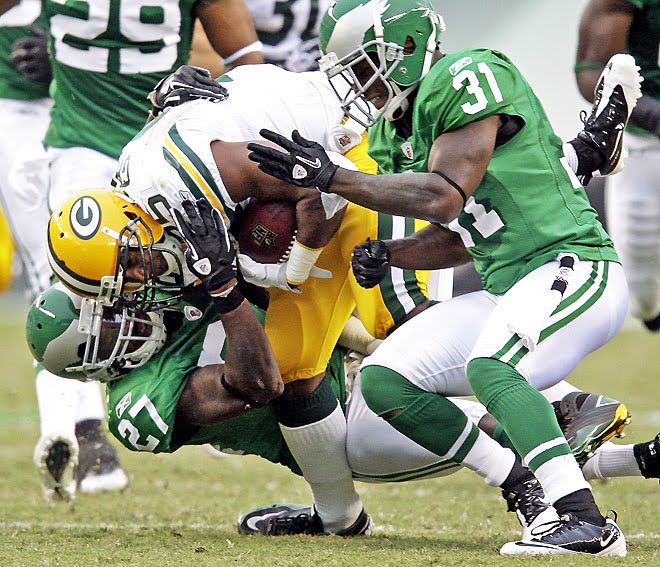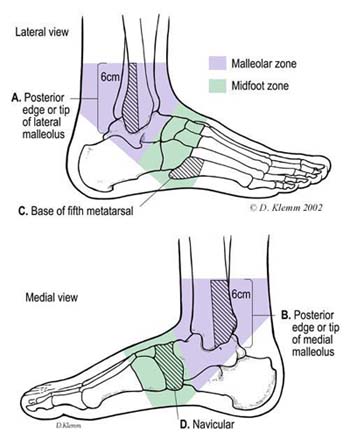
If you decide not to come to the Emergency Room for your ankle sprain, just think about the mnemonic “RICE.” (This works for any other soft tissue sprain, such as the wrist.)
Rest
The longer you stay off of it, the quicker it will heal. The more you try to use it, the longer your recovery will take and the greater the risk of aggravating the injury.
Ice
Apply ice for 15–20 minutes every hour over the first 24 hours. That will help keep the swelling and pain down. However, please keep a towel between the ice pack and your skin.
Compression/Crutches
Use an ace wrap for comfort and to help with the swelling. Use crutches to help stay off that ankle.
Elevation
This is about the only time I’ll tell you it’s ok to be a couch potato. Keep your leg elevated on the bed or on the couch at or above the level of your chest. That’ll help to keep the swelling down.
If you go to the ER, we’ll do the same for you, unless you have a fracture somewhere, in which case we’ll splint or cast you instead giving you the ace wrap. Stay safe.
Thanks for liking and following Straight, No Chaser! This public service provides a sample of what http://www.SterlingMedicalAdvice.com (SMA) will offer beginning November 1. Until then enjoy some our favorite posts and frequently asked questions as well as a daily note explaining the benefits of SMA membership. Please share our page with your Friends on WordPress, and we can be found on Facebook at SterlingMedicalAdvice.com and on Twitter at @asksterlingmd.
Copyright © 2013 · Sterling Initiatives, LLC · Powered by WordPress
Tag Archives: Ankle
Straight, No Chaser: Quick Tip – Caring for Your Ankle Sprain
Straight, No Chaser: How I Know If Your Ankle is Broken Without X-Rays – The Ottawa Ankle Rules

There are medical secrets, and there are tips. Then there are initiatives that help the public better understand what’s going on, like the big initiatives on heart attacks and strokes. I wonder why there’s never been a push to teach the public how to better deal with strains and sprains. The cumulative radiation exposure and the expense of coming to the emergency room are sufficiently high enough that we should want patients not to expect as many unwarranted x-rays as you end up receiving. Truthfully, the overwhelming majority of ankle sprains (consistently estimated at 85%) don’t have associated fractures. The initial research done in developing what are known as the Ottawa Ankle Rules demonstrated a complete absence of ankle fractures in the absence of certain exam findings.
An ankle X-ray is only required if any of the following are present (Doctor version).
- Inability to bear weight for four steps (both immediately and in the emergency room);
- Bony tenderness along the posterior edge of the distal 6 cm (almost 3 inches) of either the lateral or medial malleolus;
- Point tenderness over the proximal base of the 5th metatarsal; or
- Point tenderness over the navicular bone.
Now that was the medical terminology (I bet you thought I’d lost it for a second!). Here’s the same information translated for you.
- Inability to bear weight for four steps (both immediately and in the emergency room);
- Bony tenderness along the back of those big bones sticking out of either side of your ankle (A and B in the diagram above);
- Point tenderness right about the middle of your foot down from your pinky toe (C in the diagram); or
- Point tenderness over top of the middle of your foot (D in the diagram).
These rules aren’t applied to those under 18, intoxicated or otherwise distracted, say from another injury.
What does this mean?
- More than a third of ankle x-rays can be eliminated by applying these rules, saving you money and radiation exposure.
- If you find your physician asking you if you’d like to not have an x-ray done, you know this is what s/he’s thinking. Several major studies showed application of these rules had a 100% sensitivity. In other words, you don’t need the x-ray.
- All of you playing with your ankles have made me smile.
What this doesn’t mean for you…
- You can play doctor at home.
Finally, don’t forget about RICE, remember? That’s how you treat your ankle sprain.
Copyright © 2013 · Sterling Initiatives, LLC · Powered by WordPress

There are medical secrets, and there are tips. Then there are initiatives that help the public better understand what’s going on, like the big initiatives on heart attacks and strokes. I wonder why there’s never been a push to teach the public how to better deal with strains and sprains. The cumulative radiation exposure and the expense of coming to the emergency room are sufficiently high enough that we should want patients not to expect as many unwarranted x-rays as you end up receiving. Truthfully, the overwhelming majority of ankle sprains (consistently estimated at 85%) don’t have associated fractures. The initial research done in developing what are known as the Ottawa Ankle Rules demonstrated a complete absence of ankle fractures in the absence of certain exam findings.
An ankle X-ray is only required if any of the following are present (Doctor version).
- Inability to bear weight for four steps (both immediately and in the emergency room);
- Bony tenderness along the posterior edge of the distal 6 cm (almost 3 inches) of either the lateral or medial malleolus;
- Point tenderness over the proximal base of the 5th metatarsal; or
- Point tenderness over the navicular bone.
Now that was the medical terminology (I bet you thought I’d lost it for a second!). Here’s the same information translated for you.
- Inability to bear weight for four steps (both immediately and in the emergency room);
- Bony tenderness along the back of those big bones sticking out of either side of your ankle (A and B in the diagram above);
- Point tenderness right about the middle of your foot down from your pinky toe (C in the diagram); or
- Point tenderness over top of the middle of your foot (D in the diagram).
These rules aren’t applied to those under 18, intoxicated or otherwise distracted, say from another injury.
What does this mean?
- More than a third of ankle x-rays can be eliminated by applying these rules, saving you money and radiation exposure.
- If you find your physician asking you if you’d like to not have an x-ray done, you know this is what s/he’s thinking. Several major studies showed application of these rules had a 100% sensitivity. In other words, you don’t need the x-ray.
- All of you playing with your ankles have made me smile.
What this doesn’t mean for you…
- You can play doctor at home.
Finally, don’t forget about RICE, remember? That’s how you treat your ankle sprain.
Copyright © 2013 · Sterling Initiatives, LLC · Powered by WordPress
